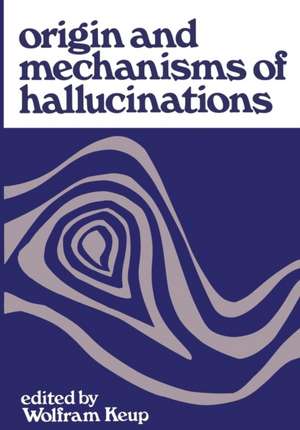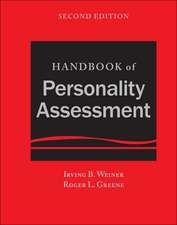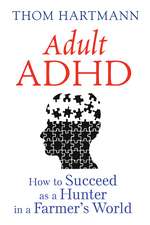Origin and Mechanisms of Hallucinations: Proceedings of the 14th Annual Meeting of the Eastern Psychiatric Research Association held in New York City, November 14–15, 1969
Editat de Wolfram Keupen Limba Engleză Paperback – 14 feb 2013
Preț: 407.19 lei
Nou
Puncte Express: 611
Preț estimativ în valută:
77.94€ • 84.69$ • 65.51£
77.94€ • 84.69$ • 65.51£
Carte tipărită la comandă
Livrare economică 21 aprilie-05 mai
Preluare comenzi: 021 569.72.76
Specificații
ISBN-13: 9781461586470
ISBN-10: 146158647X
Pagini: 504
Ilustrații: XXI, 480 p. 31 illus.
Dimensiuni: 178 x 254 x 26 mm
Greutate: 0.87 kg
Ediția:Softcover reprint of the original 1st ed. 1970
Editura: Springer Us
Colecția Springer
Locul publicării:New York, NY, United States
ISBN-10: 146158647X
Pagini: 504
Ilustrații: XXI, 480 p. 31 illus.
Dimensiuni: 178 x 254 x 26 mm
Greutate: 0.87 kg
Ediția:Softcover reprint of the original 1st ed. 1970
Editura: Springer Us
Colecția Springer
Locul publicării:New York, NY, United States
Public țintă
ResearchDescriere
Hallucinations, a natural phenomenon as old as mankind, have a surprisingly wide range. They appear under the most diversified conditions, in the "normal" psyche as well as in severe chronic mental derangement. As a symptom, hallucinations are a potential part of a variety of pathological conditions in almost all kinds of psychotic behavior. In addition, lately, various psychological and sociological circumstances seem to favor widespread use and abuse of hallucinogens, substances able to produce hallucinations in the normal brain. They not rarely lead to serious psychopatho logy such as toxic, and mobilized or aggravated endogenous psycho ses. While such development adds to our scientific knowledge, it also contributes to our current social troubles. Neurologists and neuro-surgeons, psychiatrists, psychologists and other specialized researchers constantly have been dealing with the phenomenon, its roots and branches, and yet, its primary mechanisms are largely un known. However, investigators of hallucinations now seem to enter common ground on which meaningful discussions and joint approaches become feasible and more promising. We have come a long way from the Latin term "hallucinari", meaning to talk nonsense, to be absent-minded, to the modern con cept of "hallucinations". While the Latin word was descriptive of what may be due to hallucinations, the modern concept defines hal lucinations as subjective experiences that are consequences of men tal processes, sometimes fulfilling a purpose in the individual's mental life.
Cuprins
ORGANIC BASIS OF HALLUCINATIONS.- Neurologic Syndromes and Hallucinations.- Hallucinations on Brain Stimulation: Evidence for Revision of the Penfield Hypothesis.- Visual Illusions and Hallucinations in Parieto-Occipital Lesions of the Brain.- The Influences of the Standard Prefrontal Lobotomy Operation on Hallucinatory Phenomena Associated with Psychotomimetic Drugs.- Relationships between Delusions and Hallucinations in Brain Disease.- Transactional Paths in the Reticular Activating System.- Changes in Digital Computer Analyzed EEC during “Dreams” and Experimentally Induced Hallucinations.- PSYCHOLOGICAL BASIS OF HALLUCINATIONS.- The Maturation Process and Hallucinations in Children.- Imagery and Reality: Can they be Distinguished?.- Do you see Things that aren’t there? – Construct Validity of the Concept “Hallucinations”.- Hallucinations, Dreaming and REM Sleep.- Reported Sensations and Hallucinations in Sensory Deprivation - Research Data Pertinent to Thirteen Hypotheses and a Reformulation.- Sensory Deprivation in Life Situations.- Hypnotically Induced Hallucinations: Their Diagnostic and Therapeutic Utilization.- Hypnosis, Suggestions and Auditory-Visual Hallucinations.- The Veridicality of Hypnotic, Visual Hallucinations.- Hallucination and Trance: An Anthropologist’s Perspective.- The Function of Hallucinations: An Inquiry into the Relationship of Hallucinatory Experience to Creative Thought.- Kluver’s Mechanisms of Hallucinations as Illustrated by the Paintings of Max Ernst.- BIOCHEMISTRY AND PHARMACOLOGY OF HALLUCINATIONS.- A Neuropharmacologically Based Concept of Hallucination and its Clinical Application.- Hallucinations and Clouding of Sensorium in Acute Alcohol Withdrawal Syndromes - Dependent and Independent Relationships Including Evidence for Cultural Hallucinogenic Mechanisms.- Auditory ‘Elementary Hallucinations’ in Alcohol Withdrawal Psychoses.- Comparison of Ditran Intoxication and Acute Alcohol Psychoses.- Disturbances in Tryptamine/Serotonin Metabolism Associated with Psychotic Phenomena.- Hyperventilation and Hallucinations.- Drugs, Hallucinations and Memory.- Prediction and Measurement of Perceptual-Behavioral Change in Drug-Induced Hallucinations.- Behavioral Pharmacology of the Hallucinogens.- Structure-Activity Relationship among Hallucinogenic Agents.- PSYCHOPATHOLOGY OF HALLUCINATIONS.- Toward a Structural Theory of Hallucinations.- The Pathophysiology of Schizophrenic Hallucinosis.- An Empirical Test of Several Popular Notions about Hallucinations in Schizophrenic Patients.- Hallucinations in Pre-Adolescent Schizophrenic Children.- On Common Features of the Language of Creative Performance and Hallucinogenic Drug-Induced Creative Experience.- Psychedelic Myths, Metaphors, and Fantasies.- Phenomenology of Hallucinations in the Deaf.- Post-Mastectomy Breast Phantoms.- The Function of Hallucinated Pain.- Influences of Polypharmacy on Hallucinatory Behavior in a Sample of Female Chronic Schizophrenic Patients.











